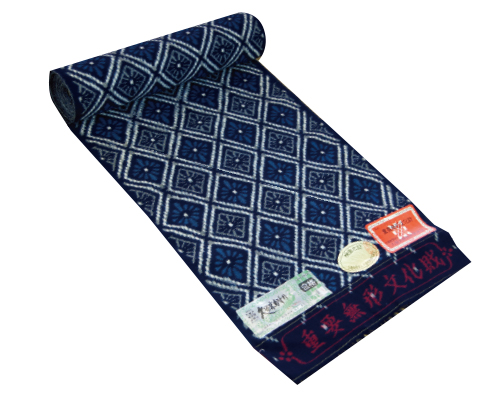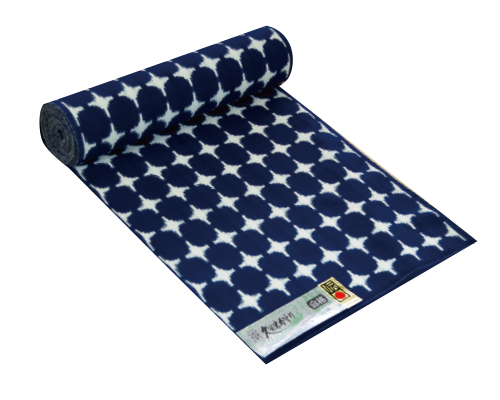Certification of Kurume Kasuri
Kurume Kasuri: From everyday goods to important intangible cultural properties
There are specific standards for the certification of Kurume Kasuri. For example, the textiles must be produced by members of the Kurume Kasuri Association, and they must be yarn-dyed narrow woven fabrics. In addition to these common standards, there are three different types of Kurume Kasuri, which are classified based on the technique and manufacturing process that is used.
● Kurume Kasuri as an important intangible cultural property
● Kurume Kasuri as a traditional handicraft
● Kikaiori (machine woven) Kurume Kasuri
Kurume Kasuri as an important intangible cultural property

In Japan, intangible skills rich in historical or artistic value are designated by the national government as important intangible cultural properties for the sake of preserving the tradition. In 1957, Kurume Kasuri was the first cotton fabric to receive this designation. Because the intangible skill itself is required to receive the designation, the people or organizations who embody these advanced skills are certified as keepers of the craft.
Conditions for certification
 ● Must use hand-wrapped dyed thread.
● Must use hand-wrapped dyed thread.● Must be dyed with natural indigo.
● Must be woven on a traditional hand loom.
Fabrics created using these techniques that pass an inspection are labeled and sold as important intangible cultural properties. These fabrics are very valuable because the quantity of Kurume Kasuri that meets these strict requirements is extremely limited.
Kurume Kasuri as a traditional handicraft

Kurume Kasuri has been designated by the Minister of Economy, Trade and Industry as a traditional handicraft. Hand-woven Kurume Kasuri that has cleared a strict set of standards set by the Kurume Kasuri Association is labeled as a traditional handicraft. This serves two purposes: to ensure customers are given proper product information and to maintain and improve the quality of Kurume Kasuri as one of Japan’s preeminent textiles.
Conditions for certification
 ● Must be produced by members of the Kurume Kasuri Association.
● Must be produced by members of the Kurume Kasuri Association.● Must be a yarn-dyed narrow weave fabric.
● Must use cotton yarn and have a hand-woven yarn-dyed warp and a plain weave weft.
● Must have a pattern suitable for a traditional handicraft.
● Must be woven with one of the following techniques or processes:
○ Must be a yarn-dyed plain weave fabric.
○ Dyed thread must be used for both the warp and the weft, or at least the weft.
○ The weft thread must be fed using either an end-feed shuttle or a foot-operated shuttle.
Kurume Kasuri - machine used

The machine used to weave the fabric is not a standard shuttle-less loom. The weft thread is fed using the same kind of shuttle used in the teori (hand weaving) style to ensure a high-quality finished product. Furthermore, chemical dyes allow for a wider range of colors.
Conditions for certification
 ● Must be produced by members of the Kurume Kasuri Association.
● Must be produced by members of the Kurume Kasuri Association.● Must be a yarn-dyed narrow weave fabric.
● The weft threat is fed using a shuttle.
